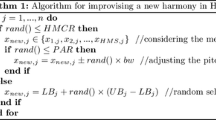Abstract
In this paper, we have formulated a fuzzy least squares version of recently proposed clustering method, namely twin support vector clustering (TWSVC). Here, a fuzzy membership value of each data pattern to different cluster is optimized and is further used for assigning each data pattern to one or other cluster. The formulation leads to finding k cluster center planes by solving modified primal problem of TWSVC, instead of the dual problem usually solved. We show that the solution of the proposed algorithm reduces to solving a series of system of linear equations as opposed to solving series of quadratic programming problems along with system of linear equations as in TWSVC. The experimental results on several publicly available datasets show that the proposed fuzzy least squares twin support vector clustering (F-LS-TWSVC) achieves comparable clustering accuracy to that of TWSVC with comparatively lesser computational time. Further, we have given an application of F-LS-TWSVC for segmentation of color images.






Similar content being viewed by others
References
Anderberg M (1973) Cluster analysis for applications. Academic Press, New York
Jain A, Murty M, Flynn P (1999) Data clustering: a review. ACM Comput Surv CSUR 31(3):264–323
Qimin C, Qiao G, Yongliang W, Xianghua W (2015) Text clustering using VSM with feature clusters. Neural Comput Appl 26(4):995–1003
Zhan Y, Yin J, Liu X (2013) Nonlinear discriminant clustering based on spectral regularization. Neural Comput Appl 22(7–8):1599–1608
Tu E, Cao L, Yang J, Kasabov N (2014) A novel graph-based k-means for nonlinear manifold clustering and representative selection. Neurocomputing 143:109–122
Liu X, Li M (2014) Integrated constraint based clustering algorithm for high dimensional data. Neurocomputing 142:478–485
Bradley P, Mangasarian O (1997) Clustering via concave minimization. Adv Neural Inf Process Syst 9:368–374
Bradley P, Mangasarian O (2000) k-Plane clustering. J Glob Optim 16(1):23–32
Shao Y, Bai L, Wang Z, Hua X, Deng N (2013) Proximal plane clustering via eigenvalues. Procedia Comput Sci 17:41–47
Yang Z, Guo Y, Li C, Shao Y (2014) Local k-proximal plane clustering. Neural Comput Appl 26(1):199–211
Jayadeva KR, Chandra S (2007) Twin support vector machines for pattern classification. IEEE Trans Pattern Anal Mach Intell 29:905–910
Mehrkanoon S, Huang X, Suykens JA (2014) Non-parallel support vector classifiers with different loss functions. Neurocomputing 143:294–301
Xie X, Sun S (2014) Multi-view Laplacian twin support vector machines. Appl Intell 41:1059–1068
Xie X, Sun S (2015) Multitask centroid twin support vector machines. Neurocomputing 149:1085–1091
Ding S, Zhang N, Zhang X, Wu F (2016) Twin support vector machine: theory, algorithm and applications. Neural Comput Appl. doi:10.1007/s00521-016-2245-4
Tian Y, Qi Z (2014) Review on: twin support vector machines. Ann Data Sci 1:253–277
Wang Z, Shao Y, Bai L, Deng N (2014) Twin support vector machine for clustering. IEEE Tran Neural Netw Learn Syst. doi:10.1109/TNNLS.2014.2379930
Fung G, Mangasarian OL (2001) Proximal support vector machine classifiers. In: Proceedings of seventh international conference on knowledge and data discovery, pp 77–86
Keller JM, Gray MR, Givens JA (1985) A fuzzy k-nearest neighbor algorithm. IEEE Trans Syst Man Cybern 4:580–585
Yuille AL, Rangarajan A (2002) The concave-convex procedure (CCCP). Adv Neural Inf Process Syst 2:1033–1040
Kumar A, Gopal M (2009) Least squares twin support vector machines for pattern classification. Exp Syst Appl 36:7535–7543
Golub GH, Van Loan CF (1996) Matrix Computations. The John Hopkins University Press, Baltimore
MATLAB (1994–2001) User’s guide. The MathsWorks, Inc. http://www.mathworks.com
Blake CL, Merz CJ (1998) UCI Repository for machine learning databases. University of California, Department of Information and Computer Sciences, Irvine. http://www.ics.uci.edu/~mlearn/MLRepository.html
Arbelaez P, Fowlkes C, Martin D (2007) The berkeley segmentation dataset and benchmark. http://www.eecs.berkeley.edu/Research/Projects/CS/vision/bsds
Mehrkanoon S, Alzate C, Mall R, Langone R, Suykens J (2015) Multiclass semisupervised learning based upon kernel spectral clustering. IEEE Trans Neural Netw Learn Syst 26(4):720–733
Wang XY, Wang T, Bu J (2011) Color image segmentation using pixel wise support vector machine classification. Pattern Recognit 44(4):777–787
Duda RO, Hart PE, Stork DG (2001) Pattern classification, 2nd edn. Wiley, New York
Huttenlocher DP, Klanderman GA, Rucklidge WJ (1993) Comparing images using the Hausdorff distance. IEEE Trans Pattern Anal Mach Intell 15(9):850–863
Sartakhti JS, Ghadiri N, Afrabandpey H (2015) Fuzzy Least squares twin support vector machines. arXiv:1505.05451
Wang X, Wang Y, Wang L (2004) Improving fuzzy c-means clustering based on feature-weight learning. Pattern Recognit Lett 25:1123–1132
Manjunath BS, Ma WY (1996) Texture features for browsing and retrieval of image data. IEEE Trans Pattern Anal Mach Intell 18(8):837–842
Acknowledgments
We are very thankful to Mr. Keshav Goyal for his initial contribution to the analysis of the draft. We are also extremely grateful to the anonymous reviewers and Editor for their valuable comments that helped us to enormously improve the quality of the paper.
Author information
Authors and Affiliations
Corresponding author
Rights and permissions
About this article
Cite this article
Khemchandani, R., Pal, A. & Chandra, S. Fuzzy least squares twin support vector clustering. Neural Comput & Applic 29, 553–563 (2018). https://doi.org/10.1007/s00521-016-2468-4
Received:
Accepted:
Published:
Issue Date:
DOI: https://doi.org/10.1007/s00521-016-2468-4




